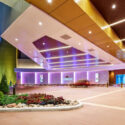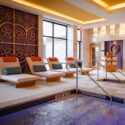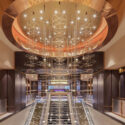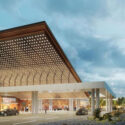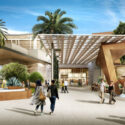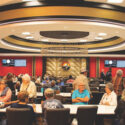At the high-end retail corridor known as Via Bellagio in Las Vegas, shops like Fendi, Giorgio Armani, Gucci and Prada could easily outfit Hollywood’s entire A-list.
Movie stars usually get such goodies for free. For the rest of us, these exclusive labels carry a high price. A clutch from Fendi or Dior can cost several thousand dollars; ditto an Armani silk suit or bauble from Tiffany & Co.
Despite the pricy product lines, the shops at Bellagio are among the most profitable shopping “malls” in the country.
In 2006, the typical regional U.S. mall averaged about $350 per square foot in revenues. (The best-performing brought in $392.) But retail located in casino environments left their suburban counterparts in the dust.
In 2006, the Forum Shops at Caesars Las Vegas posted approximately $1,300 PSF, a figure that rose to $1,500 in 2007. And some analysts whisper that this year, Via Bellagio-at the Bellagio casino resort in Vegas-could rack up an astonishing $2,000 per square foot.
Hard to believe, but the idea of putting retail in casinos was once a hard sell. In the 1980s, developer Sheldon Gordon was among the first proponents when he noted that foot traffic at Caesars Palace in Las Vegas exceeded that at Macy’s legendary department store in New York. Gordon, who ultimately developed the Forum Shops at Caesars, would be later hailed as a visionary. But first he had to overcome the ingrained conviction held by operators and retailers alike that gamblers would never shop where they play.
That conviction was not only untrue, it was the polar opposite of true. For tourists, going to the casino is like going on vacation. They expect to spend money. They’re not averse to blowing through their vacation allowance or casino winnings on a few souvenirs or the occasional big-ticket splurge.
“In the tourist environment, people tend to leave their economic sense behind,” says Brent Pirosch, director of gaming consultant services at CB Richard Ellis’s Global Gaming Group in Las Vegas. “If you have a good day at the tables, maybe a $5,000 watch for your wife isn’t out of line.”
While upscale casinos support more upscale retail (think Wynn and Bellagio in Vegas or the Pier Shops in Atlantic City), the same demographic that ogles Manolos and Maseratis readily patronizes mid-market stores like White House, Black Market and Ann Taylor. Pirosch says 10 percent to 15 percent of luxury retail is usually appropriate; it’s important, too, he adds, to serve niche consumers who aren’t drawn to mainstream apparel.
“Pay attention to who your customer is and create the kind of environment you don’t get at home.” For the alternative customer, “Maybe you want a cool, sports-themed store, like a Niketown. Or if you’re in the middle of nowhere and have your own golf course, open a high-end golf store.”
If there is any formula for success in casino retail, it’s a simple one: a great mix of shopping within walking distance of lodgings, food and gambling. Guests spend about 60 percent of their “play money” at or near their hotel, 30 percent immediately adjacent, and 10 percent elsewhere in the market; to reap the retail rewards, it’s imperative to keep them on the property as much as possible.
“The ‘why’ is partly psychological; tourists are in an unfamiliar environment, so the property becomes their ‘home,'” says Frank Volk, executive vice president of Robert K. Futterman Associates in Las Vegas and an expert on retail in the gaming capital. “The logistics of moving in and around the Vegas Strip, for example, can often be difficult and/or time-consuming. It’s far easier to shop where or near where you are staying.”
In a 24-hour environment, retailers can justify longer hours-10 a.m. to 11 p.m. on weekdays, 10 a.m. to midnight on weekends-which also boosts their bottom line.
“The important thing here for retailers is that they are getting 30 percent to 40 percent more shopping hours due extended shopping and 365 days a year of store operation,” Volk says.
‘Louis Vuitton on Every Corner’
Steve Henri, director of planning and design for national investment firm Taubman Centers Inc., has used the of the gaming-shopping alliance to good effect in Atlantic City. In 2006, Taubman added the Pier Shops at Caesars to its list of urban and suburban shopping centers.
The multilevel 46,400-square-foot venue has everything you’d expect in a suburban mall-retail, a food court-along with an indoor water show and elaborate fountain, a collection of high-end designer shops and boutiques, and dozens of food offerings, all within a quick walk of the gaming floor (Caesars Atlantic City is connected to Pier Shops by a skywalk over the famous Boardwarlk).
Moving from Atlantic City to Las Vegas, retail “sometimes outperforms the gaming revenue,” Henri says. “It’s a big, significant piece of the income.”
To succeed, casino-based retailers in Atlantic City strive to attract a broad swath of customers, not just the traditional older gambler who once arrived here by bus, but that veteran patron’s children and grandchildren too, as well as the locals.
“It’s the LA experience-the anchor is the casino, but you want to appeal to everybody,” says Henri. Shoppers can browse at the Pier Shops Hugo Boss, Louis Vuitton, Armani A/X, bebe and Burberry as well niche shops like The Art of Shaving, where a deluxe razor goes for $1,000.
The Pier Shops offer the kind of products vacationers wouldn’t normally buy at home: “Luxury items, out-of-the-ordinary items, impulse items,” says Henri. High-priced retail adds to the “holiday” experience; casinos recognize that and embrace it.
“You have to do a lot to keep people from leaving your property,” says Henri. “You have to have everything the other guy has, plus something else.”
He believes the growing diversity of casino patrons presents an as-yet-untapped market for casinos and retailers alike. When you successfully capture the right patrons, “You could put a Louis Vuitton store on every corner, and they’d all do well.”
Image-Maker, Moneymaker
At Harrah’s Atlantic City, Senior Vice President and General Manager Scott Barber says retail was always an important component of the 44-story Waterfront Tower, which opened this year.
“We looked at customers coming today and we looked at customers we wanted to attract tomorrow,” he says. “Once we determined that retail was high on the list, we included it in the plan.”
All Waterfront Tower retail is owned and operated by the Harrah’s organization. Not all casinos handle the retail component this way, but for Harrah’s it was a natural fit.
“We already have a very established corporate retail department,” says Barber. “We wanted to create a seamless transition for our rewards customers.” The decision allows them better control of product line in the stores and simplifies the use of comp points as well.
Harrah’s wanted seamlessness from a design perspective. Guests who leave their cars with a valet attendant enter through an amber dome with stained glass accents. The hum of slot machines beckons from the right, and Park Place Jewelers from the left. The placement of retail space is instantly visible on arrival. Seventy percent of the hotel rooms are positioned in the tower at the center of the shopping corridor.
“You have to walk right past the retail space to get to those rooms,” says Barber. “We wanted to create that foot traffic.”
As at the Pier Shops, retail at the Waterfront Tower aims for a wide demographic, though families are not targeted. The seven shops offer designer clothing, shoes, home goods and of course, jewelry.
“Our jewelry store has just been a huge hit,” Barber says, adding that Sony performed second or third in sales volume from the beginning. But changes are underway.
“Electronics have been very popular,” but customers want “more lifestyle-type merchandise,” Barber says. In the spring, the Sony store was replaced by Innovations, which will offer everything from toasters and blenders to televisions and video games. The store will carry Sony but other brands as well.
Harrah’s Total Rewards loyalty program helps it identify the top selling merchandise.
“Our customers can use comp dollars to purchase out of catalogs, so we know literally the types of products that are most popular with our market,” Barber says.
By offering special “multiplier days,” where points are doubled or tripled on site, Harrah’s entices guests to come back for another day of shopping, dining and gaming.
“We wanted our retail to be integrated with the rest of the casino,” with a gallery of shops and dining designed to make customers feel they are at a true upscale beach resort, Barber says. Marble and aquamarine lights line the corridor, and both the retail and dining options conjure subtle images of a beach resort with natural light flooding the area from the hotel’s palm-tree dotted pool area.
The resort’s dining options include gourmet in addition to the Taste of the Shore food court and the dazzling Waterfront Buffet.
“Our approach to food is very similar to our approach to retail,” Barber says. “We wanted to make sure there were quick options as well as fine dining options.”
Variety is the key to successfully tapping its market, Barber says. “Our priority customer is our casino customer. Our goal is to increase the length of stay so we offer the kinds of amenities to encourage that.”
The amenities include a posh pool, Elizabeth Arden’s Red Door Spa, dining and a 15,000-square-foot-shopping gallery. The obvious bonus to that approach is that the whole resort becomes a destination, not only for gamers, but for those who bypass the casino floor for the diamonds in the window.
Building Aspirations
Executives at Borgata Hotel Casino & Spa in Atlantic City use the term “aspirational” to describe their target audience. The buzzword describes people who want to “trade up,” says Jordan Covell, executive director of retail operations at the Borgata.
“From the beginning, we wanted to reach those in search of a full-scale, full-fledged casino resort experience-those who wanted something more like Las Vegas.”
To attract the right visitors-including those famously dubbed “Atlantic City rejecters”-the upscale operator employed retail as a critical component of the mix. The casino included 11 retail shops including Whim, Borgata’s 5,000-square-foot version of a logo shop.
“We took a different approach because our client demands a different product,” says Covell. In fact, the store offers a whole slew of unique products including Borgata bedding, electronics and designer clothing, like 7 Jeans that sell for $200 a pair.
“Envy No One” is the store’s trademark slogan, which sums up Borgata’s overall approach.
The operator is applying the same philosophy to the 9,000-square-foot retail space at the new Water Club, a non-casino tower next to Borgata.
The shopping area is strategically placed in the corridor connecting Borgata with the Water Club. The amenities within each property will be shared, but each store will be “very distinct, very different” from its neighbors, Covell says.
Borgata and Water Club will continue to own and operate some of the shops on site, including Whim, but they also bring in high-end designers like Hugo Boss, Just Cavalli and Hearts of Fire jewelers to provide their guests with a signature shopping experience.
Luxury is an important component, and the goal is to reach the sophisticated consumer who knows and craves up-market retail and designer specialty stores. The retail shops are united by elements like marble, fine wood and elaborate chandeliers, but “they are built out to stand out,” Covell says.
Each space is a signal to the resort’s urbane customer base that Borgata and the Water Club provide what is hot now, “like Fifth Avenue at your fingertips,” Covell says.
Supersize Me
Expand the Borgata/Water Club concept, add an Italian accent, and you’ve got both two of the most popular shopping venues in Vegas: The Grand Canal Shoppes at the Venetian and the Shoppes at the Palazzo.
Together the destinations offer a stateside shopping trip to Venice courtesy of General Growth Properties (GGP), which, like Taubman, is a real estate trust company that buys and builds shopping malls.
In 2004, GGP bought the Grand Canal Shoppes from Las Vegas Sands, which had built the shopping area as part of the Venetian in 1999. In January, the company opened 60 more retail shops at the Palazzo.
According to Susan Houck, vice president of marketing, GGP operates five shopping areas totaling more than 5 million square feet in Las Vegas alone. The industry trend, Houck says, is to offer hotel and casino guests the very best in amenities: “world renowned spas, signature chef restaurants, unique lounges and nightclubs and the very best retail boutiques available. Shopping and dining are becoming as important as gaming today.”
And the demand is still growing. GGP is working with Echelon and Boyd Gaming on a new project, High Street, a luxury retail space set to open in Las Vegas in 2010.
“Las Vegas is a unique retail environment,” Houck says. “The Grand Canal Shoppes at the Venetian comprise a completely different experience than The Shoppes at the Palazzo, and each represents the culture of the resort they live in.”
Together the distinct but complementary venues offer 160 retail shops over 800,000 square feet of shopping space. The Grand Canal Shoppes offer an experiential visit to Venice, with touristy attractions like gondola rides. The Shoppes at the Palazzo focus on luxury brands including Christian Louboutin, Piaget, Diane von Furstenberg, Bottega Veneta and Ralph Lauren. Thirty of the 60 new shops are firsts on the Nevada retail scene.
“We have a strong leasing team that works closely with our casino partners to determine the right retail fit to complement the environment the resort is trying to project,” Houck says. The mix is critical to the casino and the renting retail stores since it both serves and grows the market. Houck agrees with Taubman’s Henri that in the right market, there’s never too much Louis Vuitton-in fact, her words echo his almost exactly.
“Louis Vuitton is a powerful brand, internationally recognized. We could have a Louis Vuitton on every corner and they would all continue to do great sales.”
With casinos facing more and more competition and flagging revenues, retail may be more vital than ever to attract and retain patrons. Though the casinos do not see a significant amount of direct revenue from retail-they are typically getting rent-RKF’s Volk says the benefit is “the incremental dollar spillover from a visitor to the shopping venue.”
According to Mark Birtha, vice president of development for Marriott International Lodging Development, retail, dining, and entertainment help to “insulate casino revenue, which can be volatile at times while these others are traditionally more stable.”
Sheldon Gordon was among the first to see the light. The rest of the industry has fallen in line. As for the future, Birtha foresees an even greater integration of these disparate parts.
“In years to come,” he says, “we’ll see the actual fusion of the gaming space with retail and other non-gaming components. We’re already seeing casino lounges or privès that have the look and feel of nightclubs with the equally exciting energy of tables and slots. We will see retail venues housed in or around the casino floor, with changing ambiances, lighting, and sound and provide customers with both gaming and shopping products.
“We may even see casino spaces designed and defined with the flavor of an iconic retail partner who caters to a similar customer. Both product enhancement and innovation will push the boundaries of the casino and allow for other significant revenue generators,” thus redefining the gaming experience.






